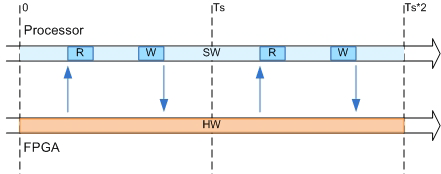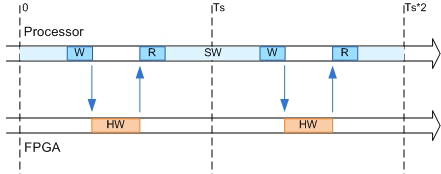Processor and FPGA Synchronization
In the HDL Workflow Advisor, you can choose a Processor/FPGA synchronization mode for your processor and FPGA when you generate a custom IP core to use in an embedded system integration project. The following synchronization modes are available:
Free running(default)Coprocessing – blockingCoprocessing – nonblocking with delay
Free Running Mode
In free running mode, the processor and FPGA each run nonsynchronized, continuously, and in parallel.
Select Free running as the Processor/FPGA synchronization mode when you do not want your processor and FPGA to be automatically synchronized.
The following diagram shows how the processor and FPGA can communicate in free running mode. The shaded areas indicate that the processor and FPGA are running continuously.

Coprocessing – Blocking Mode
In blocking coprocessor mode, HDL Coder™ automatically generates synchronization logic for the FPGA so that the processor and FPGA run in tandem.
Select Coprocessing – blocking as the Processor/FPGA synchronization mode when FPGA execution time is short relative to the processor sample time, and you want the FPGA to complete before the processor continues.
The following diagram shows how the processor and FPGA run in blocking coprocessing mode.

The shaded areas indicate when the processor and FPGA are running. During each sample time, the processor writes to the FPGA, then stops and waits for an indication that the FPGA has finished processing before continuing to run. Each time the FPGA runs, it executes the logic generated for one DUT subsystem sample time.